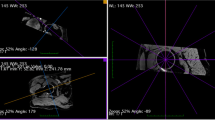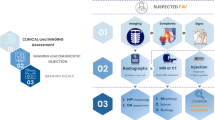Abstract
Insufficient femoral head-neck offset is common in femoroacetabular impingement (FAI) and reflected by the alpha angle, a validated measurement for quantifying this anatomic deformity in patients with FAI. We compared the alpha angle determined on magnetic resonance imaging (MRI) oblique axial plane images with the maximal alpha angle value obtained using radial images. The MRIs of 41 subjects with clinically suspected FAI were reviewed and alpha angle measurements were performed on both oblique axial plane images parallel to the long axis of the femoral neck and radial images obtained using the center of the femoral neck as the axis of rotation. The mean oblique axial plane and mean maximal radial alpha angle values were 53.4° and 70.5°, respectively. In 54% of subjects, the alpha angle was less than 55° on the conventional oblique axial plane image but 55° or greater on the radial plane images. Radial images yielded higher alpha angle values than oblique axial images. Patients with clinically suspected FAI may have a substantial contour abnormality that can be underestimated or missed if only oblique axial plane images are reviewed. Radial plane imaging should be considered in the MRI investigation of FAI.
Level of Evidence: Level III, diagnostic study. See the Guidelines for Authors for a complete description of levels of evidence.



Similar content being viewed by others
References
Beaulé P, Zaragoza E, Motamedi E, Copelan N, Dorey F. Three-dimensional computed tomography of the hip in the assessment of femoroacetabular impingement. J Orthop Res. 2005;23:1286–1292.
Beck M, Kalhor M, Leunig M, Ganz R. Hip morphology influences the pattern of damage to the acetabular cartilage. J Bone Joint Surg Br. 2005;87:1012–1018.
Ganz R, Leunig M, Leunig-Ganz K, Harris WH. The etiology of osteoarthritis of the hip: an integrated mechanical concept. Clin Orthop Relat Res. 2008;466:264–272.
Ganz R, Parvizi J, Beck M, Leunig M, Nötzli H, Siebenrock KA. Femoroacetabular impingement: a cause for osteoarthritis of the hip. Clin Orthop Relat Res. 2003;417:112–120.
Ito K, Minka KA, Leunig M, Werlen S, Ganz R. Femoroacetabular impingement and the cam-effect: a MRI-based quantitative anatomical study of the femoral head-neck offset. J Bone Joint Surg Br. 2001;83:171–176.
James SLJ, Ali K, Malara F, Young D, O’Donnell J, Connell DA. MRI findings of femoroacetabular impingement. AJR Am J Roentgenol. 2006;187:1412–1419.
Kassarjian A, Yoon LS, Belzile E, Connolly SA, Millis MB, Palmer WE. Triad of MR arthrographic findings in patients with cam-type femoroacetabular impingement. Radiology. 2005;236:588–592.
Meyer DC, Beck M, Ellis T, Ganz R, Leunig M. Comparison of six radiographic projections to assess femoral head/neck asphericity. Clin Orthop Relat Res. 2006;445:181–185.
Nötzli HP, Wyss TF, Stoecklin CH, Schmid MR, Treiber K, Hodler J. The contour of the femoral head-neck junction as a predictor for the risk of anterior impingement. J Bone Joint Surg Br. 2002;84:556–560.
Pfirrmann CWA, Mengiardi B, Dora C, Kalberer F, Zanetti M, Hodler J. Cam and pincer Femoroacetabular impingement: characteristic MR arthrographic findings in 50 patients. Radiology. 2006;240:778–785.
Siebenrock KA, Wahab KHA, Werlen S, Kalhor M, Leunig M, Ganz R. Abnormal extension of the femoral head epiphysis as a cause of cam impingement. Clin Orthop Relat Res. 2004;418:54–60.
Tannast M, Sienbenrock KA, Anderson SE. Femoroacetabular impingement: radiographic diagnosis—what the radiologist should know. AJR Am J Roentgenol. 2007;188:1540–1552.
Acknowledgments
We thank Anna Fazekas and Simon Dagenais for assistance in study design and statistical analysis and Natasha La Russa for postprocessing reformations of the MRI studies.
Author information
Authors and Affiliations
Corresponding author
Additional information
Each author certifies that he or she has no commercial associations (eg, consultancies, stock ownership, equity interest, patent/licensing arrangements, etc) that might pose a conflict of interest in connection with the submitted article.
Each author certifies that his or her institution has approved or waived approval for the human protocol for this investigation and that all investigations were conducted in conformity with ethical principles of research.
About this article
Cite this article
Rakhra, K.S., Sheikh, A.M., Allen, D. et al. Comparison of MRI Alpha Angle Measurement Planes in Femoroacetabular Impingement. Clin Orthop Relat Res 467, 660–665 (2009). https://doi.org/10.1007/s11999-008-0627-3
Received:
Accepted:
Published:
Issue Date:
DOI: https://doi.org/10.1007/s11999-008-0627-3




